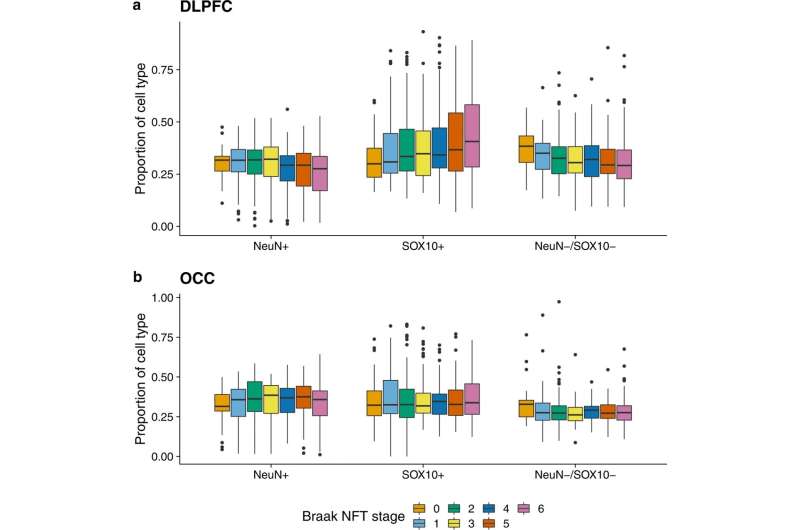Study is first to show role of genomic changes in specific brain cells in Alzheimer's disease

New research—which studied genomic changes in different types of brain cells—has yielded a potentially surprising result: many of the changes in Alzheimer's disease are in brain cells other than neurons, the cells that actually die as the disease progresses. The cutting-edge research also revealed a number of new genes not previously implicated in dementia, which could be targets for future drug development.
The study, led by the University of Exeter and published in Nature Communications, is the largest of its kind to look at DNA methylation in Alzheimer's disease. DNA methylation is the process by which the activity of genes is regulated, acting a bit like a dimmer-switch to turn genes on or off. Increasingly, this process is thought to have a key role in the development of diseases such as dementia.
So far, research on DNA methylation in the brain has only been able to look at "bulk" samples of post-mortem tissue. In other words, scientists have been limited to looking at average levels of DNA methylations across all the different cell types in a piece of brain tissue. Now, the Exeter team has developed a technique to "purify" the cell populations, meaning they can see DNA methylation activity in each distinct cell type for the first time.
Research lead Jonathan Mill, Professor of Epigenomics at the University of Exeter Medical School, says that the "study has enabled us to explore the changes associated with the development of dementia across individual populations of cells. It's often assumed that these changes primarily occur in neurons, but surprisingly we found much more dramatic shifts in non-neuronal cell-types. This means we can start to understand more about the mechanisms involved in disease and identify pathways that might be targetable by novel drugs".
The research utilized 631 brain samples donated to the Brains for Dementia Research cohort, which included people who died with Alzheimer's disease. From each person, the team dissected two distinct regions of the cortex that are affected differently in Alzheimer's disease. Each donor had very comprehensive measures of the pathology of the brain taken at post-mortem, providing the team with very detailed information about the progression of the disease.
Professor Mill added that the "study highlights the power of using multiple measures of neuropathology to identify epigenetic signatures of Alzheimer's disease, as well as the importance of looking at the activity of different types of cell, and when and how they are activated in disease. The generosity of the people who donated their brains for research has allowed us to make these exciting discoveries and could hold the key to finding new treatments for Alzheimer's disease."
Dr. Richard Oakley, Associate Director of Research, at Alzheimer's Society, says that they "need to understand how the diseases that cause dementia develop to find the very best treatments. This Alzheimer's Society funded study is a fantastic example of using a gold standard resource in understanding dementia, through brains generously donated by people who lived with dementia to Brains for Dementia Research, which we're proud to co-fund."
"The results here form another piece of the puzzle—it's not just the nerve cells which are affected in Alzheimer's disease, but also the other types of cells in the brain which support them. We've known that changes to genes in these cells are involved, but this shows for the first time that changes to the 'dimmer switches' which turn these genes on and off in the brain's support cells also play a key role in the development of Alzheimer's disease."
"Through an exciting, cutting-edge technique, this was the first time researchers were able to examine these changes in specific groups of brain cells. Further research will enable researchers to pinpoint exactly what is going wrong inside brain cells to cause dementia, and will inform how we develop new targeted treatments for the different diseases of the brain that cause dementia, which are so desperately needed for people living with dementia today and in the future."
The paper, "DNA methylation signatures of Alzheimer's disease neuropathology in the cortex are primarily driven by variation in non-neuronal cell-types," is published in Nature Communications.
More information: Gemma Shireby et al, DNA methylation signatures of Alzheimer's disease neuropathology in the cortex are primarily driven by variation in non-neuronal cell-types, Nature Communications (2022). DOI: 10.1038/s41467-022-33394-7





















